There’s a reason flying saucers keep popping up on Michael Northuis’ canvases . . .
Last month, an anthropologist from Montana Technological University joined two Harvard researchers – a psychologist and an associate director of its Human Flourishing Program – to speculate on the roots of UAP/UFOs. The premise was so heretical, it was introduced with a disclaimer. “We believe in all likelihood this hypothesis is false,” Harvard’s HFP stated with italicized emphasis, “but nevertheless believe it still merits scientific investigation.”
Drawing from sources as diverse as Jules Verne and David Grusch, the 42-page single-spaced tome served up the entire kitchen sink of origin theories about advanced nonhuman intelligence. From Atlantis and Lemuria to Carl Sagan and Dr. Oz, from the Epic of Gilgamesh and Noah’s flood to the National Academy of Sciences and congressional testimony, the treatise cast a sprawling net for clues to support what it’s calling CTH – the cryptoterrestrial hypothesis.
Eighty years of the Extraterrestrial Hypothesis, after all, haven’t gotten us any closer to bringing the culprits to justice. Maybe we’re looking through the wrong end of the telescope. Maybe UFO operators are based underground, beneath the waves, in echoes of prehistoric ancestors. “If NHI were a terrestrial species,” argued the authors, “their species might well be related to Homo sapiens in some way . . . which would more easily account for their resemblance.” In other words, The Other might even be sipping latte at the next table over and you wouldn’t even notice.
Emboldened speculation is running in every direction lately. Researchers with the Royal Astronomical Society announced last month their investigation into seven stars emitting extremely odd infrared heat. The signatures are so odd, in fact, that RAS’s best guess at this point includes Dyson spheres, i.e., hypothesized artificial megastructures left by an advanced civilization.
But for at least a few folks, part of the problem is words.
Note the triangle motif: “Woman With UFO (Vicky),” Michael Northuis
“It was probably 1965, I was 15 or 16 years old. We were in western Michigan, Holland. My best friend Ron and I were watching TV, it was a fall evening, really nice, kinda cool, dry air. Not a lot of atmospheric distortion like you might get on a warm, balmy night. And it was dark, maybe around 9:30. I heard my older brother drive up in the garage, it was an Oldsmobile 88, it made kind of a rumbling sound.”
The V-8 engine, no doubt. Michael Northuis lives in Greensboro, North Carolina now. He tells the story like it happened yesterday.
“He and his girlfriend came running in and he said ‘Mike, you gotta come out and see this – there’s a spaceship out here.’ Well, my brother was kind of a nut, he was a notorious kidder and was always trying to make me do something. The first thing I thought was, he wants to get our seats so they could watch TV.
“But his girlfriend was crying. She was almost hysterical. So we went outside.”
Northuis is an artist and painting instructor with the Art Alliance of Greensboro. A sample of his work was recently selected for an exhibition at the GreenHill Center for NC Art downtown, under the theme “LEAP: Artists Imagine Outer Space.”
“There’s this big field beyond our house, and a factory is kind of above that big field. And this thing was motionless, just hovering there. It’s hard to wrap your head around what you’re seeing, something so foreign. I saw it as mushroom-shaped. It had a cylinder coming out of the center of this . . . saucer. The cylinder was kinda short, but it had red and white light moving or pulsing around the bottom. The light looked, I don’t know, more like an orchestrated electrical charge than, like, a movie theater marquee with lightbulbs.”
“Left Behind by the Billionaire Games,” Bryant Portwood. The exhibition at GreenHill Center for NC Art runs through June 29.
“Then it suddenly moved laterally, to another place, kinda parallel to the horizon. It moved so quickly, it was almost in a blink, like you didn’t actually see it move. It stayed there and then it went upward at an angle. It was there for a moment, then went back to the original point. I guess you could say it basically drew a triangle before our eyes.”
Maybe it was a quarter mile away. Hard to tell in the dark. Maybe it was the size of a tractor trailer rig. In a flash, it reduced the mighty hell-on-wheels Olds in the garage to obsolescence.
“It took off directly in our line of vision so we could actually see it move. It went from zero to outer space in about a second and a half – it was just gone. There’s a small airport nearby and we see this small plane, a Piper Cub, coming through our airspace and it was almost deafening to hear it, which made us realize what we’d seen had been completely silent.
“We sat there kinda dumbfounded and it didn’t come back. So we decided to call the sheriff, and they said we weren’t the only ones, other people had called in, too. I guess, looking back, the whole thing lasted for maybe two, three minutes.
“I probably started drawing it in class the next day. I wanted to tell people about it, but they kinda brushed it off, saying it must’ve been a military experiment or something, but they didn’t want to hear about it. So I quit talking about it.”
Photo collage “Escaping the Chaos,” by Rondell Lane, at the gallery doorway.
Two years ago, exhibition curator Edie Carpenter, working with artists with North Carolina roots or connections, began gathering artwork projecting what an off-world future might look like. Guided by the “idea that space is a source of inspiration and a place for the imagination,” Carpenter booked 25 artists into a modest 400-square foot display space. The offerings are kid-friendly and often whimsical, but cynicism is a recurring theme.
Cecil Norris, for instance, envisions a rocket emblazoned with logos from Amazon Wal-Mart, Apple, Google, and Mobil. Photographer Rondell Lane’s “Escaping the Chaos” offers a way out of a no-win future – getting beamed aboard a UFO. Bryant Portwood’s “Left Behind by the Billionaire Games” imagines an exit ramp available only to those who can afford it.
“The discussions about the commercialism and weaponization of space – and everything else – are probably going to get very intense in the next few years, and artists are always at the forefront of the values of society,” says Carpenter. “The whole vocabulary of space really refers to what’s going on at home. But we can look at the universe as a place where we can leave our social problems behind and embrace a brave new world, a frontier for surrealist imagination, and man as a new kind of being.
“I was listening to Ken Burns’ commencement speech the other day and was struck by what he said about how human nature never changes. There will be major discoveries that will inspire us in the future, but we have some cautionary tales in this show. I’m not sure human nature will change.”
‘A global consensus’
Flying saucers don’t dominate Michael Northuis’ work, but they make frequent appearances. Maybe, he concedes, he’s been overdosing on the “Ancient Aliens” series. But the more he contemplates what vanished civilizations left behind, the more he warms to the cryptoterrestrial idea.
“What I really love is all the old artwork,” he says. “The human record is artwork to some degree. Seeing the representations in relation to what we’re calling aliens is interesting. Every culture has its stories about the gods coming out of the sky and interacting with humanity – it’s like a global consensus. There’s no question in my mind that they’ve been here for a long time.”
When Northuis’ childhood buddy and fellow eyewitness, Ron, dropped in from Michigan recently, they compared notes for the first time in years. Everything they remembered about that evening lined up – except for what the UFO looked like. “Ron said he thought it was more of a square-shaped craft,” Northuis recalls. “Kinda hard to know what to make of that.”
Fifty-nine years gone.
“I guess it means more to me today than it did back then. Especially now that the government’s finally coming out and admitting military people are having these encounters, too. I look back on it, and the fact that it kinda drew a triangle, almost like it was looking at us looking at it . . . that was quite profound. I mean, a triangle, that’s the symbol of God, the Trinity . . . and the geometry behind it – there’s so many ways you can reflect on that.”
An end-of-the-world scenario from Kris Saintsing
Extraterrestrial, cryptoterrestrial or the fog in between — ultimately, does it even matter? From a policy level, there is no path forward. We’re on our own. The cave wall artists probably did the best they could. One of their descendants, Kris Saintsing, has an exhibition piece called “Ma, the Invaders Are Terraforming.” A barefoot old codger is relaxing in his Adirondack chair as flying saucers fire laser beams to zap the land behind him. Two signs – “The End Is Nigh” and an alien-faced “Welcome” greeting – lay face-up on the porch, in pyrrhic vindication.
Fortunately, Gramps has a dog.




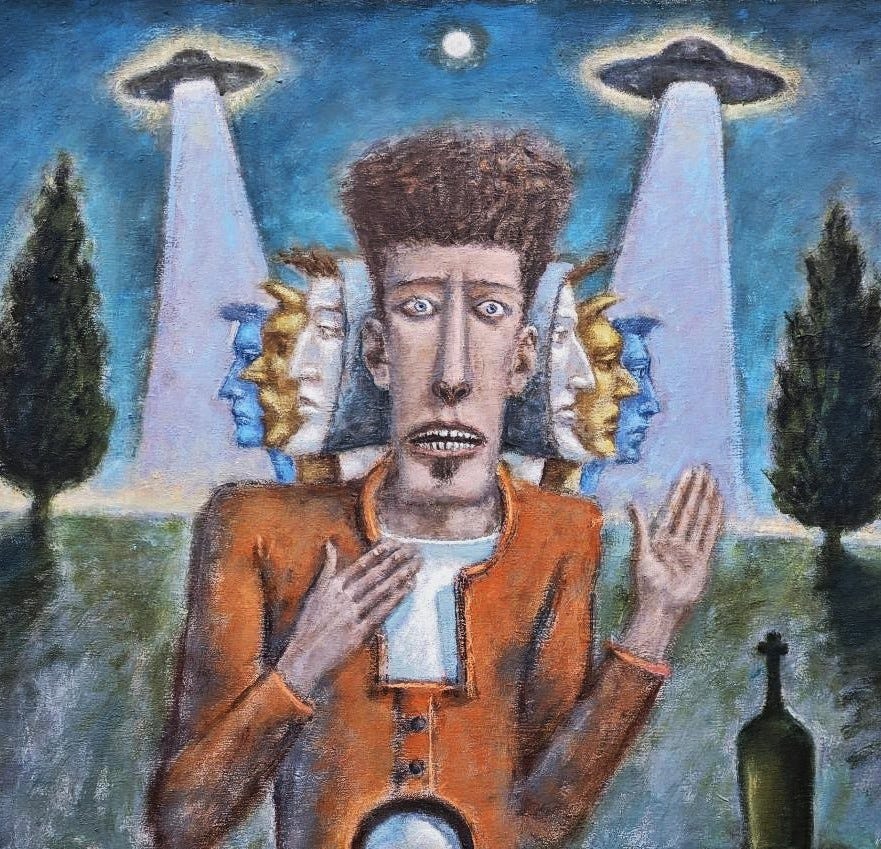
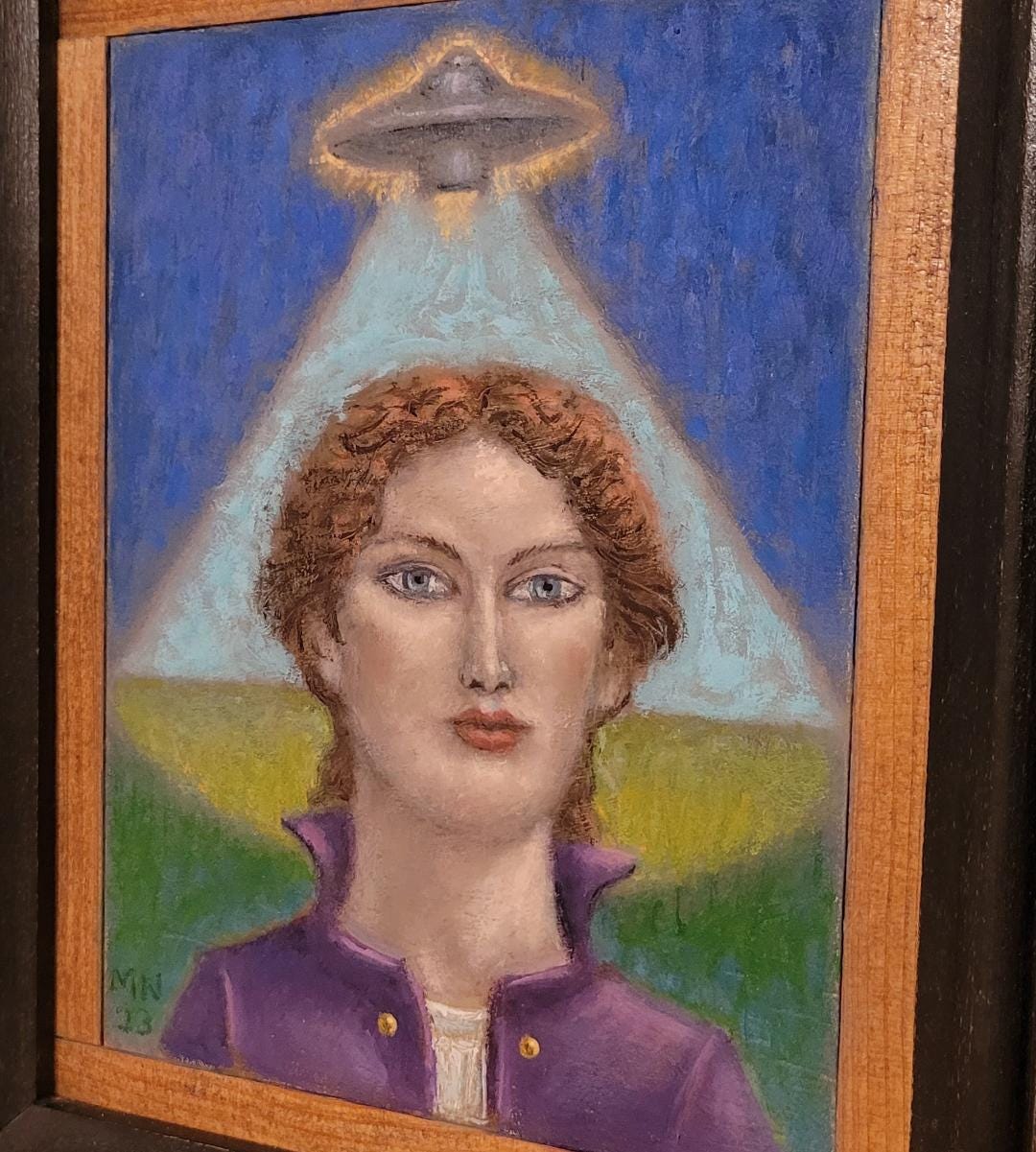
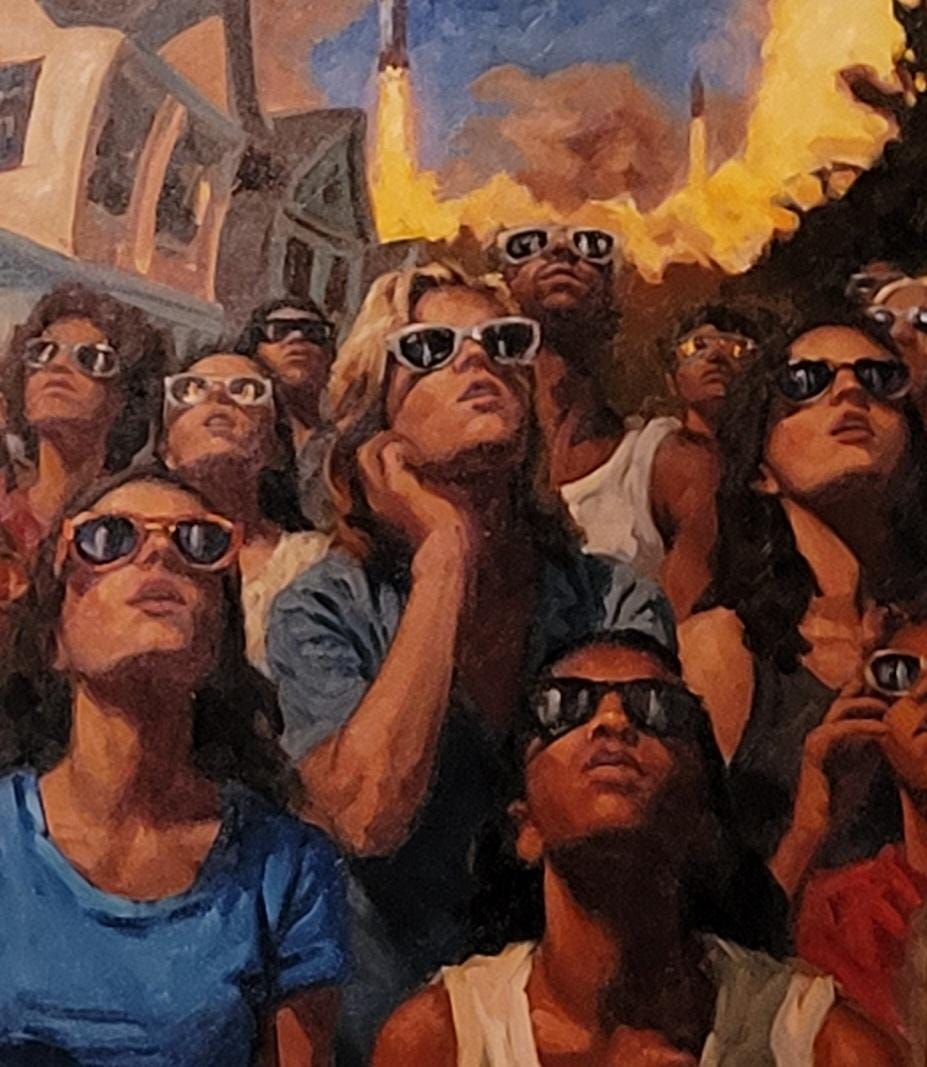
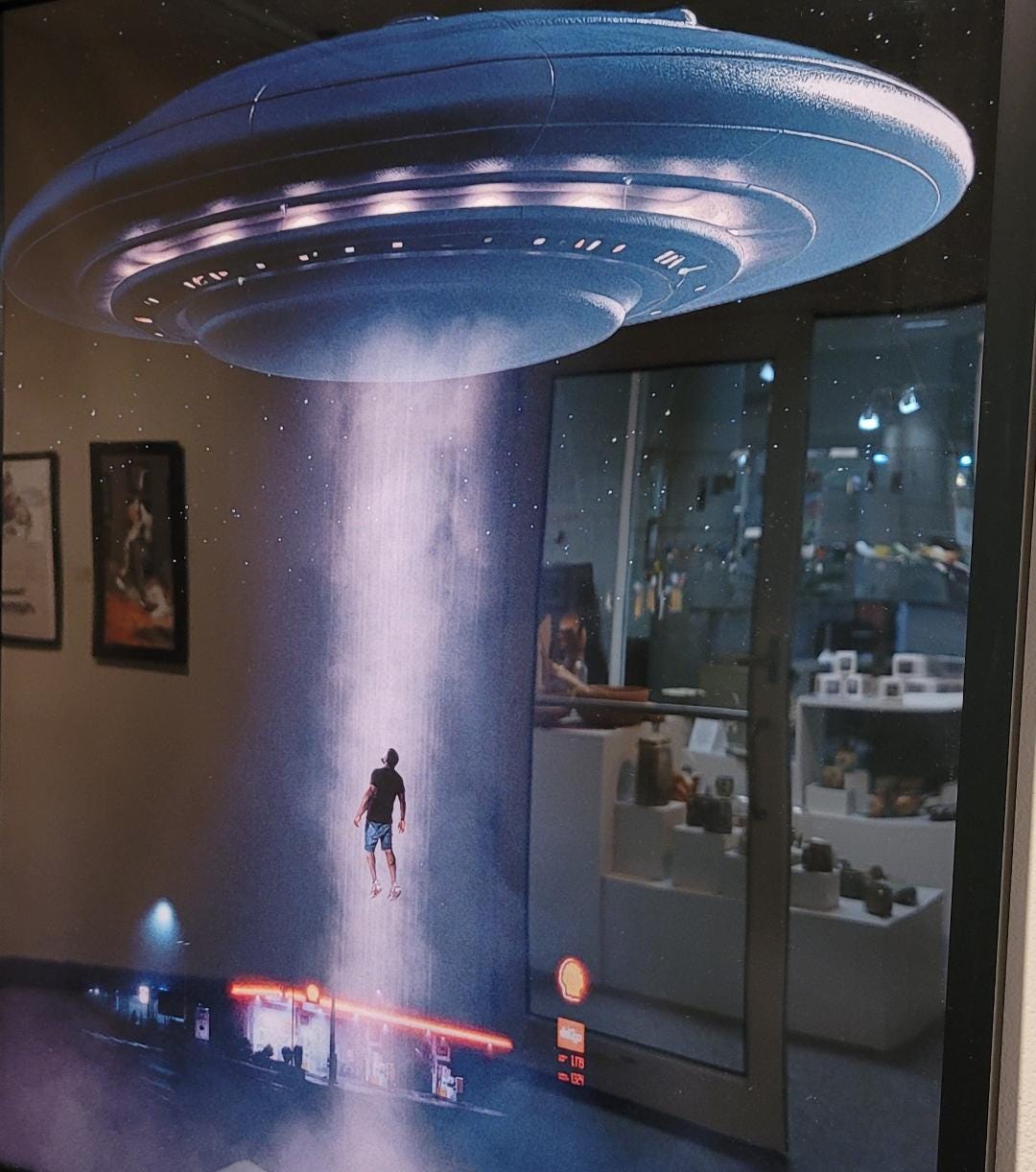
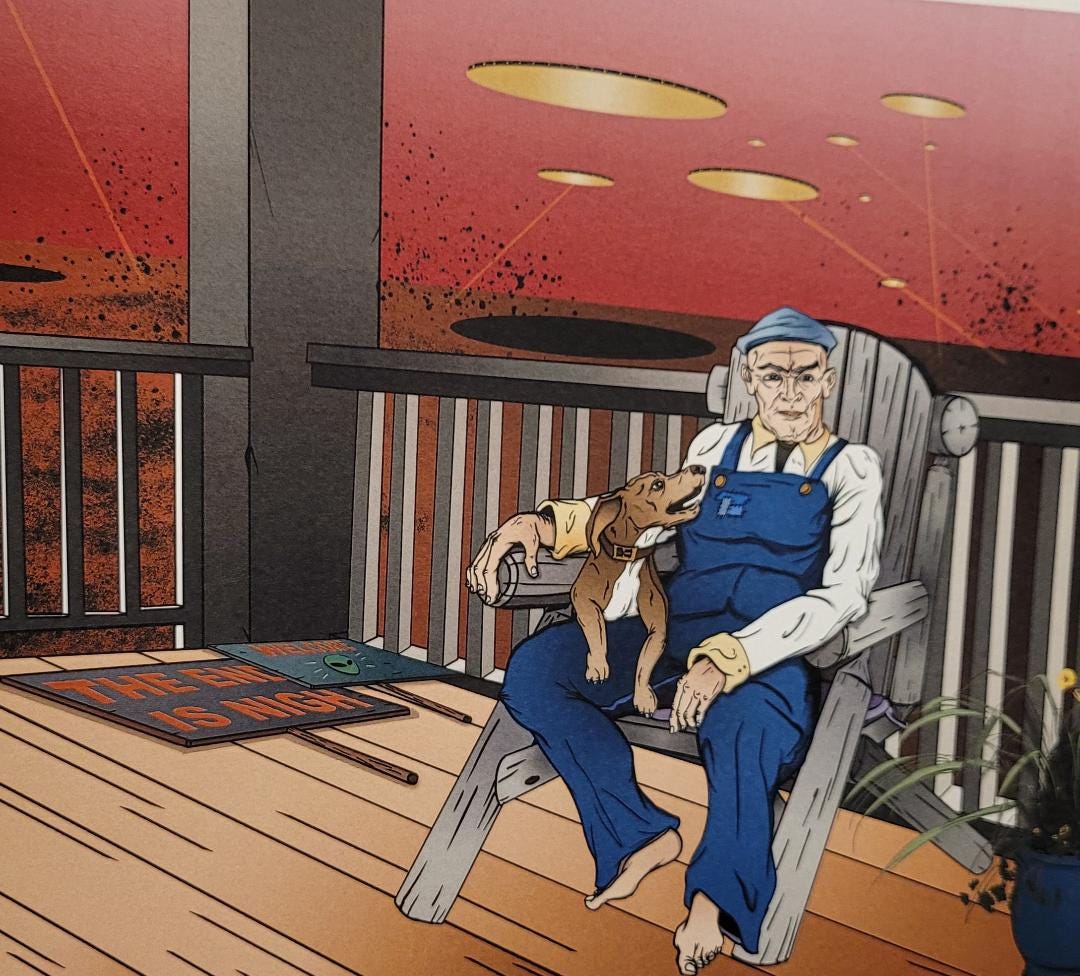
Thank you for this (and all your previous articles) The LEAP Show looks very interesting. I'm based in Ireland so I thankfully from your wonderful words and photos I got a good sense of the exhibition. Have a great weekend, P.
Gramps and his dog would be good introductory content for an updated return version of the "far side " calendar.. Seriously, Hal Puthoff wrote a compelling OP-ED a few years ago questioning if the ultraterrestrial hypothesis should be given a plausible second look, as opposed to the prevalent ETH.
Makes sense to me.